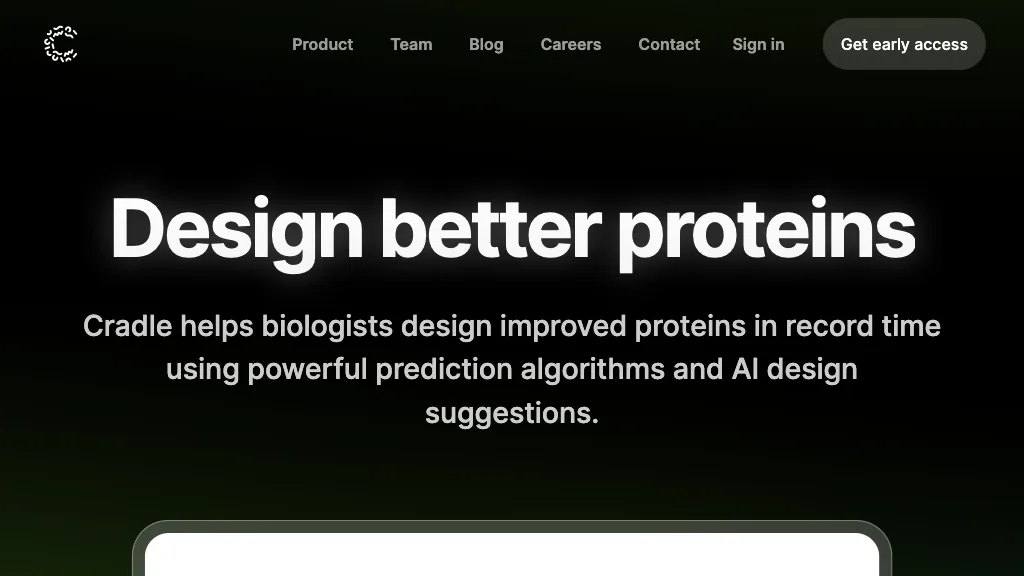What is Cradl?
Cradle is a state-of-the-art AI tool applied to the design and optimization of protein structures by biologists at relatively high speed. Cradle facilitates high throughput screening, with predictive algorithms and AI-driven design proposals, and offers an intuitive user interface to create new designs and optimize codons. It is highly effective for improving a wide array of protein attributes, including stability, activity, specificity, and affinity, all while ensuring the security and privacy of the sequence data and providing total ownership of intellectual property.
Cradl was developed by a group of experts coming from leading backgrounds in biology, bioengineering, design, and machine learning. Cradl stays upfront as a credible and sophisticated solution in protein design and optimization.
Cradl Key Features & Benefits
Cradl hosts a full-fledged suite of features for addressing biologists and researchers. Let’s review its remarkable features:
- Design and improve protein structures: AI now allows the creation and refinement of protein structures with far greater efficiency.
- High throughput screening: High throughput screening processes can now be performed in shorter lengths of time and more effectively.
- AI-assisted design tool: AI will help in generating new sequences and optimizing codons.
- Optimization of protein stability: The better the stability, the better the performance.
- Activity optimization: The activity of the protein is optimized to meet the requirements.
- Specificity optimization: Optimizing specificity makes the proteins target certain outcomes.
- Affinity optimization: Increase the target affinity for each of the proteins.
- Sequence data privacy and security: Make every sequence data private and secure.
- Ownership of intellectual property: Your intellectual property belongs to you.
The totality of these features will make Cradl a very helpful place for biologists in order to be innovative in protein design and optimization.
Use Cases and Applications of Cradl
Cradle is flexible and can be used in various areas of biology. Some concrete examples include:
- Design protein sequences: Design new protein sequences with properties for particular purposes.
- Optimize codons to design proteins: Optimize the codons for good protein expression and functionality.
- Enhance protein stability, activity specificity, and affinity: Refine the protein for better performance against predetermined criteria.
Cradl is primarily useful to biologists and researchers in drug discovery, synthetic biology, and bioengineering. Since the tool automates the process of designing proteins, it will be of great help in any laboratory.
Using Cradl
The usage of Cradl is relatively simple to get started with. Here is a step-by-step guide on how to use the tool:
- Registration and login: Create an account and log in on the Cradl platform.
- Input data: Please input the protein sequence data you want to analyze or optimize.
- Choose parameters: Please choose what attributes you would like to have optimized, including stability or activity.
- Run the analysis: Employ the AI-powered design tool to develop new sequences or optimize already existent ones.
- Analyze results: Go through the results Cradl provides and makes changes if necessary.
- Apply changes: Apply the optimized sequences to your research or development projects.
It is highly recommended to be comfortable with the user interface and navigate through most of the features in the tool. Updating knowledge on AI and protein design quite frequently would also enhance your Cradl experience.
How Cradl Works
Cradl applies advanced predictive algorithms and AI models. These technologies interact by analyzing the sequence of proteins and suggesting optimizations. The usual workflow involves:
- Input: The user inputs the protein sequences of interest in the platform.
- AI analysis: The AI algorithms analyze the sequences and find their weak points.
- Design suggestions: Cradl gives AI-powered suggestions for new sequences or optimizations.
- Implementation: Users can then apply those suggestions to enhance the performance.
This ensures proteins are optimized in an efficient manner. This frees up time, which is so valuable for the researchers.
Pros and Cons of Cradl
There is no perfect tool; Cradl enjoys its share of pros and cons, like every other tool. Let’s discuss both:
Pros
- Efficient design and optimization of proteins
- High throughput screening capabilities.
- AI-designed platform for generating new sequences.
- Privacy and security of sequence data.
- Full ownership of intellectual property.
Possible Cons
- Learning curve for new users.
- Optimal performances depend on the accuracy of input data.
User reviews generally feature the effectiveness and efficiency of Cradl, making it one of t










